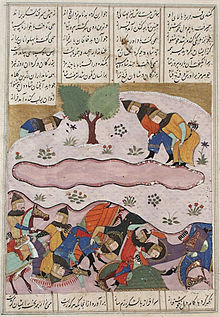Hephthalite–Sasanian War of 484
| Hephthalite–Sasanian War of 484 | |||||||
|---|---|---|---|---|---|---|---|
| Part of Hephthalite–Sasanian Wars | |||||||
 The defeat and death of Peroz I in the Shahnameh. | |||||||
| |||||||
| Belligerents | |||||||
|
Hephthalite Empire | Sasanian Empire | ||||||
| Commanders and leaders | |||||||
|
Khushnavaz |
Peroz I † Mihran † | ||||||
| Strength | |||||||
| Unknown | Unknown | ||||||
| Casualties and losses | |||||||
| Unknown | Entire army[1] | ||||||
The Hephthalite–Sasanian War of 484 was a
Context
In 459, the Hephthalites occupied Bactria and were confronted by the forces of the Sassanid king, Hormizd III. It was then that Peroz, in an apparent pact with the Hephthalites,[2] killed Hormizd, his brother, and established himself as the new king. He would go on to kill the majority of his family and began a persecution of various Christian sects in his territories.
Peroz quickly moved to maintain peaceful relations with the
It was this humiliating defeat which led Peroz to launch a new campaign against the Hephthalites.
The battle
In 484, after the liberation of his son, Peroz formed an enormous army and marched northeast to confront the Hephthalites. The king marched his forces all the way to
In Procopius's account, the Hephthalites used an overextended and camouflaged ditch to defeat the Sasanians, but the Khonsarinejad et al. (2021) argues the ditch story to be dubious.[6]
Aftermath
The Huns invaded the Sassanid territories which had been left without a central government following the death of the king. Much of the Sassanid land was pillaged repeatedly for a period of two years
According to
References
- ^ a b Payne 2015b, p. 287.
- ^ a b Frye, 1996: 178
- ^ McDonough 2011, p. 305.
- ^ a b Schindel 2013a, pp. 136–141.
- ^ Potts 2018, p. 295.
- ISSN 2299-2464.
- ^ Christian, 1998: 220
- ^ a b Dani, 1999: 140
- ISBN 978-0-88402-214-5.
Sources
- ISBN 0-631-20814-3.
- ISBN 1-55876-111-X.
- ISBN 81-208-1540-8.
- McDonough, Scott (2011). "The Legs of the Throne: Kings, Elites, and Subjects in Sasanian Iran". In Arnason, Johann P.; Raaflaub, Kurt A. (eds.). The Roman Empire in Context: Historical and Comparative Perspectives. John Wiley & Sons, Ltd. pp. 290–321. ISBN 9781444390186.
- Schindel, Nikolaus (2013a). "Kawād I i. Reign". Encyclopaedia Iranica, Vol. XVI, Fasc. 2. pp. 136–141.
- Payne, Richard (2015b). "The Reinvention of Iran: The Sasanian Empire and the Huns". In Maas, Michael (ed.). The Cambridge Companion to the Age of Attila. Cambridge University Press. pp. 282–299. ISBN 978-1-107-63388-9.
- Rezakhani, Khodadad (2017). "East Iran in Late Antiquity". ReOrienting the Sasanians: East Iran in Late Antiquity. Edinburgh University Press. pp. 1–256. )
- Potts, Daniel T. (2018). "Sasanian Iran and its northeastern frontier". In Mass, Michael; Di Cosmo, Nicola (eds.). Empires and Exchanges in Eurasian Late Antiquity. Cambridge University Press. pp. 1–538. ISBN 9781316146040.
- Payne, Richard (2016). "The Making of Turan: The Fall and Transformation of the Iranian East in Late Antiquity". Journal of Late Antiquity. 9. Johns Hopkins University Press: 4–41. S2CID 156673274.
